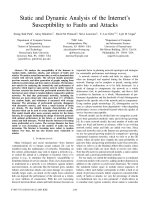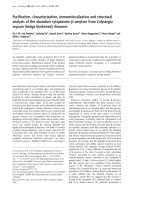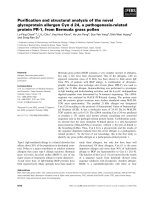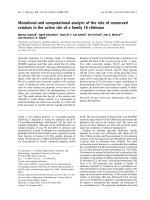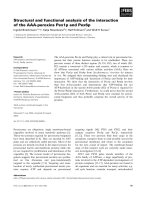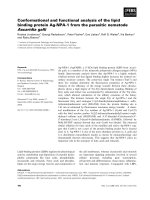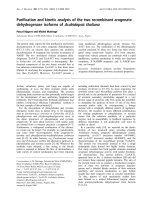BUSINESS CYCLES: A Theoretical, Historical and Statistical Analysis of the Capitalist Process potx
Bạn đang xem bản rút gọn của tài liệu. Xem và tải ngay bản đầy đủ của tài liệu tại đây (1.51 MB, 385 trang )
Joseph A. Schumpeter
[1883-1950]
Économiste autrichien classique, professeur à l'Université de Harvard,
aux États-Unis, à partir de 1932, 1883-1950
(1939)
BUSINESS CYCLES
A Theoretical, Historical and Statistical
Analysis of the Capitalist Process
Abridged, with an introduction, by Rendigs Fels
Un document produit en version numérique par Didier LAGRANGE, bénévole,
Chef de projets dans une entreprise du secteur automobile, France
Courriel:
Dans le cadre de: "Les classiques des sciences sociales"
Une bibliothèque numérique fondée et dirigée par Jean-Marie Tremblay,
professeur de sociologie au Cégep de Chicoutimi
Site web: />
Une collection développée en collaboration avec la Bibliothèque
Paul-Émile-Boulet de l'Université du Québec à Chicoutimi
Site web: />
Joseph Schumpeter, Business Cycles. (1939) 2
Cette édition électronique a été réalisée par Didier LAGRANGE, bénévole, Chef de
projets dans une entreprise du secteur automobile, France à partir de :
Joseph A. Schumpeter [1883-1950]
BUSINESS CYCLES. A Theoretical, Historical and Statistical Analysis of
the Capitalist Process.
New York Toronto London : McGraw-Hill Book Company, 1939, 461 pp.
Abridged, with an introduction, by Rendigs Fels
Polices de caractères utilisée :
Pour le texte: Times New Roman, 14 points.
Pour les citations : Times New Roman, 12 points.
Pour les notes de bas de page : Times New Roman, 12 points.
Édition électronique réalisée avec le traitement de textes Microsoft Word
2004 pour Macintosh.
Mise en page sur papier format : LETTRE (US letter), 8.5’’ x 11’’)
Édition numérique réalisée le 14 juillet 2007 à Chicoutimi,
Ville de Saguenay, province de Québec, Canada. Fichier revu
et corrigé le 31 mars 2008.
Joseph Schumpeter, Business Cycles. (1939) 3
Joseph A. Schumpeter [1883-1950]
BUSINESS CYCLES.
A Theoretical, Historical and Statistical Analysis
of the Capitalist Process.
New York Toronto London : McGraw-Hill Book Company, 1939, 461 pp.
Abridged, with an introduction, by Rendigs Fels
Joseph Schumpeter, Business Cycles. (1939) 4
Table of Contents
I. EDITOR'S INTRODUCTION
II. Chapter I.
INTRODUCTORY
III. Chapter II. EQUILIBRIUM AND THE THEORETICAL NORM OF
ECONOMIC QUANTITIES
A.
The Meaning of a Model
B. The Fundamental Question
C. The Stationary Flow
D. Equilibrium and the Theoretical Norm
E. Complications and Clarifications
F. Imperfect Competition
G. Equilibrium Economics and the Study of Business Fluctuations
IV. Chapter III. HOW THE ECONOMIC SYSTEM GENERATES EVOLU-
TION
A. Internal Factors of Change
B. The Theory of Innovation
C. The Entrepreneur and His Profit
D. The Role of Money and Banking in the Process of Evolution
E. Interest (Money Market; Capital)
V. Chapter IV. THE CONTOURS OF ECONOMIC EVOLUTION
A. The Working of the Model; First Approximation
B. Looking at the Skeleton
C. The Secondary Wave; Second Approximation
D. Many Simultaneous Cycles; Third Approximation
VI. Chapter V. TIME SERIES AND THEIR NORMAL
A.
Introduction
B. Trend
C. A Single Cyclical Movement
D. Many Simultaneous Waves
Joseph Schumpeter, Business Cycles. (1939) 5
VII. Chapter VI. HISTORICAL OUTLINES. I. INTRODUCTION; 1786-1842
A.
The Fundamental Importance of the Historical Approach to the Prob-
lems of the Cyclical Process of Evolution.
B. Questions of Principle. —A few questions of principle must be dis-
posed of first
C. The Long Wave from 1787 to 1842
VIII. Chapter VII.
HISTORICAL OUTLINES. II. 1843-1913
A. The Period 1843-1897.
B. The Agricultural Situations of the Period
C. Railroadization
D. Some Features of the Development of Manufactures
E. The First Sixteen Years of the Third Kondratieff (1893-1913)
IX. Chapter VIII. 1919-1929
A. Postwar Events and Postwar Problems
B. Comments on Postwar Patterns
C. Further Comments on Postwar Conditions
D. Outlines of Economic History from 1919 to 1929
E. The "Industrial Revolution" of the Twenties
Joseph Schumpeter, Business Cycles. (1939) 6
Joseph Schumpeter,
BUSINESS CYCLES (1939)
I.
EDITOR’S INTRODUCTION
RENDIGS Fels -
Vanderbilt University
Table of Contents
"The younger generation of economists should look upon this book
merely as something to shoot at and start from—as a motivated pro-
gram for further research."'—Joseph A. Schumpeter, Preface to Busi-
ness Cycles, 1939 edition, p. v.
Schumpeter had bad luck with Business Cycles.
1
The most ambi-
tious work of the trilogy setting forth "the Schumpeterian system," it
has attracted less attention than his Theory of Economic Develop-
ment
2
or his Capitalism, Socialism, and Democracy.
3
It is true that a
reference to Business Cycles can occasionally be found in a footnote,
but the text to which the footnote is appended rarely contains a dis-
1
The full citation is Joseph A. Schumpeter, Business Cycles : A Theoretical,
Historical, and Statistical Analysis of the Capitalist Process, 1
st
edition (New
York and London : McGraw-Hill Book Company, Inc., 1939}. Schumpeter,
an Austrian economist who spent the last eighteen years of his life at Har-
vard, was born in 1883 and died in 1950. For an account of his life see the
"Memorial" by Arthur Smithies in the American Economic Review, Sep-
tember 1950, pp. 628-45.
2
The Theory of Economic Development ; an Inquiry into Profits, Capital,
Credit, Interst, and the Business Cycle, translated from the German by Red-
vers Opie (Cambridge, Mass. : Harvard University Press, 1934).
3
3d edition (New York : Harper & Brothers Publishers, 1950).
Joseph Schumpeter, Business Cycles. (1939) 7
criminating discussion of its ideas. Clemence and Doody accorded it
its proper place in The Schumpeterian System, but they preferred de-
fending their former teacher against criticism to paying him the higher
compliment of building on his work.
4
The publication date of Business Cycles proved singularly unfor-
tunate. Had it appeared three years before Keynes's General Theory
sent economists scurrying off in other directions instead of three years'
afterwards, it would have gained from the enormous interest everyone
had in business cycles in 1933 and might have been accorded a recep-
tion second only to that later received by the General Theory itself.
5
Instead, it appeared just as the outbreak of World War II raised eco-
nomic problems to which Keynes's tools, but not Schumpeter's, could
be readily adapted. But Business Cycles lost almost as much from ap-
pearing six years too soon as from appearing six years too late. Given
a different title, it might in 1945 have profited from the growing inter-
est in economic development, for its theme is as much how the pre-
sent industrial nations developed as the themes indicated by its title
and subtitle. Modern scholars can hardly be blamed if they turn for
Schumpeter's ideas on the subject that currently fascinates them to a
book called The Theory of Economic Development rather than to a
book called Business Cycles.
They might have done so even if the titles had been reversed ; they
might well prefer the shorter, more finished account to the longer, less
polished one. The kind of fault that contributed to the success of
Keynes's General Theory added to the neglect of Schumpeter's Busi-
ness Cycles. Both would have been better books had their authors
spent another year improving them. Whereas the shortcomings of the
General Theory stimulated other economists to lay bare and refine and
4
Richard V. Clemence and Francis S. Doody, The Schumpeterian System
(Cambridge, Mass. : Addison-Wesley Press, 1950).
5
John M. Keynes, The General Theory of Employment, Interest, and Money
(New York : Harcourt, Brace and Company, 1936).
Joseph Schumpeter, Business Cycles. (1939) 8
apply the model half-concealed in it, incidentally making Keynesians
of them, the similar need to clarify and improve and use the Schum-
peterian model repelled them. There are no Schumpeterians. One need
not take issue with Schumpeter's criticism of Marshall for lavishing
too much time on the eight editions of the Principles to hold that he
himself made the opposite error.
6
Though a quarter of a century has elapsed since the first edition of
Business Cycles, the opportunities it opened up for further research
remain largely unexploited. The chief exception is Schumpeter's own
Capitalism, Socialism, and Democracy. Much has been published on
innovation and entrepreneurship, usually with a nod in Schumpeter's
direction but no more. Even a work like Yusif A. Sayigh's Entrepre-
neurs of Lebanon, which ostensibly takes Schumpeter's concepts as its
starting point, actually deals with entrepreneurs as people—their edu-
cation, religion, opinions, even the number of their children—to the
neglect of what was central to Schumpeter's analysis, innovating ac-
tivity and its impact.
7
At the time Business Cycles was written, work on Kuznets cy-
cles—the long swings of fifteen to twenty years—was still at an early
stage. Since then a large amount of statistical and a small amount of
analytical work has gone forward. Those who have made the principal
efforts to explain Kuznets cycles, Matthews and Abramovitz, have not
seen fit to draw on Schumpeter's work but have resorted to an incom-
plete and essentially aggregative tool, the capital-stock adjustment
principle.
8
(It is ironic that a generation of economists that tegards
6
«Alfred Marshall, Principles of Economics, 8th edition (London : Macmil-
lan and Co., limited, 1922).
7
Entrepreneurs of Lebanon ; The Role of the Burine» Leader in a Developing
Economy (Cambridge, Mass. : Harvard University Press, 1962).
8
R.C.O. Matthews, The Business Cycle (Chicago : University of Chicago
Press, 1959), Ch. 12 ; Moses Abramovitz, "The Nature and Significance of
Kuznets Cycles," Economic Development and Cultural Change, April 1961,
pp. 225-48.
Joseph Schumpeter, Business Cycles. (1939) 9
disaggregation as a shining virtue has underestimated the theory of
such a staunch opponent of aggregation as Schumpeter. In our heart of
hearts, we prefer the aggregates of Keynes, Harrod, Domar, etc. ; de-
spite Walras's earlier and better claim to a general theory, we permit-
ted Keynes to take over the term, Schumpeter's objections notwith-
standing. Our cant about disaggregation means only that we have
guilty consciences.) Yet Schumpeter's concept of recesssion could be
exceedingly helpful in interpreting the 1870s, a period which raises a
problem ignored by Matthews and Abramovitz in the works cited in
the footnote above. Their most telling evidence for the existence of
Kuznets cycles consists of two circumstances, swings in the rate of
growth of real GNP that average fifteen to twenty years, and the re-
currence of deep depressions at similar intervals—there was one in the
1870s, one in the 1890s, there would (or might) have been one in the
1910s but for World War I, and there was one in the 1930s. Including
1873-78 in the category of deep depressions at first sight seems rea-
sonable enough, since it is generally considered not only the longest
but also one of the worst business contractions on record. But
Abramovitz shows a "tentative" peak in the rate of growth of real
GNP, after eliminating the effects of business cycles, which he dates
1874.25.9 This means that the average annual rate of growth between
the complete business cycle with peaks in 1869 and 1873 and the
complete business cycle with peaks in 1873 and 1882 was higher than
for neighboring pairs of cycles—in fact it was the highest on record
for any successive pairs of cycles, in spite of the fact that the contrac-
tion included in the 1873-82 period is rated a deep depression,
whereas the contraction phase of the preceding cycle was very mild.
Thus the statistical finding about the rate of growth of real GNP col-
lides with the judgment that 1873-78 was a deep depression ; further-
more, it plays hob with Abramovitz's analysis of the way Kuznets cy-
cles unfold, in which deep depressions and troughs in growth rates go
together. How can the paradox of a rapid rate of growth in a period
encompassing deep depression be resolved ? Schumpeter's concept of
recession could illuminate it : previous innovation must have made
possible a great increase in output that imposed hardship—symptoms
Joseph Schumpeter, Business Cycles. (1939) 10
of depression—on all parts of the economy unable to adapt to the new
conditions. Not that one can turn to Schumpeter's own account of the
1870s for a ready-made explanation of the facts Matthews and
Abramovitz have wrestled with ; it is rather that today's economists
are missing an opportunity to build on Schumpeter's work.
The importance of a book is judged by what it leads to. By this
test, it is doubtful if Schumpeter's Business Cycles would merit rescue
from the limbo of "out of print." The first reason for the present edi-
tion lies in the conviction that it can yet stimulate significant research.
Why an abridged edition ? Ordinarily, I deplore abridgements, but in
the present case there is every reason to believe that a shorter version
will prove more useful, especially since the longer one will always be
available in libraries. Eliminating digressions and the less valuable
parts of the original two volumes, which ran to more than a thousand
pages, will enable the reader, I hope, to spend his time more profita-
bly. Having myself spent a great deal of labor trying to master the
original edition, I have nothing but sympathy for economists who felt
that it was not worth the effort
In the work of abridgement, my first concern has been to preserve
a complete statement of the theory, since less thorough accounts are
readily available elsewhere. This has meant retaining most of Chap-
ters II, HI, and IV and parts of Chapters I and V. Even in Chapters II-
IV, however, I have not hesitated to cut footnotes, paragraphs, and
whole pages where the discussion seemed to go pretty far afield, as
well as deleting superfluous sentences and phrases. Although I hope
that what remains is somewhat more readable than the original, it is
still hard going, and I would have liked to add as an appendix a sum-
mary of Schumpeter's theory that I prepared for my own use many
years ago. But it seemed better to save the space for Schumpeter's
own words. Besides, an excellent summary of Schumpeter's theory is
Joseph Schumpeter, Business Cycles. (1939) 11
already available in Clemence and Doody's The Schumpeterian Sys-
tem.
9
My second concern was to retain a full account of the interpreta-
tion of the cyclical history of one country, in preference to partial ac-
counts of the three countries that Schumpeter discussed at length. The
nature of the theory, which includes a Kondratieff cycle sixty years in
duration, calls for a long sweep of history. That the country chosen
should be the United States rather than England or Germany reflects
more than the national origins of editor and publisher. The United
States was the country Schumpeter devoted most attention to and, par-
ticularly in the discussion of the 1930s, is the one that best illustrates
the working of his model.
The decisions to keep fairly complete accounts of the theory and of
its application to one country dictated omitting virtually all the statis-
tical analysis (Chapters VII-XIII and a long section of Chapter XIV of
the original edition). One of the reviews that appeared not long after
the 1939 edition was published criticized it for not having a service-
able statistical technique. The criticism was just, and omitting the sta-
tistical chapters may be deemed no great loss. Perhaps it would have
been desirable to have cut them heavily, retaining the parts most use-
ful for throwing light on the implications of the theory, but the
abridged edition is quite long enough as it is.
I have regularly deleted references to sources of information. Since
Schumpeter's sources ace now obsolescent, if not obsolete, very few
readers would be interested in them.
9
Moses Abramovitz, Statement in United States Congress, Joint Economic
Committee, Employment, Growth, and Price Levels, Hearings (86th Con-
gress, 1st Session), Part II (Washington : Government Printing Office,
1959), p. 434.
Joseph Schumpeter, Business Cycles. (1939) 12
Schumpeter's style ran not only to frequent digressions, which I
have tried to eliminate, but also to surplus words, to stating what is
already implied, to burdening the reader with phrases that distract his
attention. In such a sentence as, "It is surely not too much to ask
economists to realize that behavior in human societies differs from
behavior in animal societies or in physical systems" (p. 1046 of the
1939 edition), I have deleted the italicized words without using dots to
so indicate. Occasionally it was convenient to alter the punctuation. I
have generally resisted the temptation to substitute a word or two of
my own, even where doing so could have saved a good deal of space,
on grounds that my words would have to be in square brackets which
would distract the reader ; but I have, on rare occasions, taken the lib-
erty of rearranging Schumpeter's own words. To give an extreme ex-
ample, a passage on p. 31 of the first edition reads, "We cannot enter
here into the epistemological problem of the relation between 'theory'
and 'facts.' But it must be emphasized that what will be said in this
chapter and those following is, in part, nothing but a generalized for-
mulation of some of the facts presented later. Therefore the term veri-
fication does not accurately describe that relation." Wanting to omit
the first sentence, I transposed a few words from it to the last, which
in this edition reads, "Therefore, the term verification does not accu-
rately describe the relation between 'theory' and 'facts.' "
There are severe limits to what an editor may properly do. I wish
Schumpeter were still alive to do the rewriting the book cries out for.
Since that is not possible, McGraw-Hill is to be commended for de-
ciding on its own initiative to publish an abridged edition.
RENDIGS Fels - Vanderbilt University
10
10
Op cit., pp. 7-21.
Joseph Schumpeter, Business Cycles. (1939) 13
Joseph Schumpeter,
BUSINESS CYCLES (1939)
II
Chapter I
Introductory
Table of Contents
Among the factors which determine any given business situation
there are some which act from within and some which act from with-
out the economic sphere. Economic consideration can fully account
for the former only ; the latter must be accepted as data and all we can
do about them in economic analysis is to explain their effects on eco-
nomic life. Hence we arrive at the very important concept of factors
acting from without {let us call them External Factors), which it
stands to reason we must try to abstract from when working out an
explanation of the causation of economic fluctuations properly so
called, that is, of those economic changes which are inherent in the
working of the economic organism itself.
11
The best examples of what we mean by an external factor are of-
fered by such events as the great Tokyo earthquake, the virtue of
which from our standpoint consists in the fact that no one has thought
11
The effects of these external factors will be called the external irregularities
of our material, as distinguished from its internal irregularities, to be defined
later
Joseph Schumpeter, Business Cycles. (1939) 14
of attributing responsibility for them to our industrial system. When-
ever a disturbance is the product of social processes, the difficult
question arises whether it is not as much a consequence as a cause of
economic events and situations and hence whether we are within our
rights if we speak of it as "acting from without the economic sphere."
In a deeper sense, the answer is undoubtedly in the negative. But for
our purpose it is yet permissible to draw a line between the phenom-
ena directly incident to the working of the economic system and the
phenomena produced by other social agencies acting on the economic
system, however obviously this action may be conditioned by eco-
nomic situations or propelled by economic aim or class interest. In a
sense, therefore, we may within the limited range of our investigation
look upon wars, danger of war, revolutions, and social unrest as exter-
nal factors. Changes in the tariff policy of a country or in its System
of taxation, measures of social betterment, and government regula-
tions of all kinds we include in the same class. After all, there is
probably little that could be objected to in our recognition of the fact
that it would not help us much, for instance in an analysis of the prob-
lems of foreign exchange, to deal indiscriminately with cases in which
exchanges are determined by commercial factors alone and cases in
which they are "pegged" as the French exchange was during the war.
And this is all that our distinction amounts to so far. But for obvious
reasons it is less easy to carry out the distinction in other cases, and
great care—carried even to the extent of hairsplitting—is required in
order to do justice to the endless variety of the social patterns we en-
counter.
Variations of crops due to natural causes, such as weather condi-
tions or plagues, raise a problem only because of the difficulty of
separating them from variations due to other causes. But for this, we
could class them with the effects of earthquakes. Gold discoveries
also could be listed in the same category as far as they may be consid-
ered, from the standpoint of the business organism, to be chance
events. But it is a fact that variations in the total supply of gold often
come about in response to business situations and in exactly the same
Joseph Schumpeter, Business Cycles. (1939) 15
way as variations in the supply of any other commodity. The varia-
tions in the monetary supply of gold are never conditioned by chance
discoveries alone. Hence we have here a case of mixed character not
always easy to interpret.
This, however, raises the question of discoveries of new countries
and of what is readily seen to be for our purposes similar in character
and effect, inventions. Both create new possibilities and are no doubt
among the most important causes of economic and social change. But
are they external factors in our sense ? Our answers will best be given
by way of examples. If we scrutinize the motives and methods of Co-
lumbus's venture, we find that it would be by no means absurd to call
it a business venture. In this case it would be just as much an element
of the business situation as is any other enterprise. But if we refuse to
do this, the discovery of America does not thereby become an external
factor, for it was not directly relevant to the course of the economic
process at all. It acquired relevance only as and when the new possi-
bilities were turned into commercial and industrial reality, and then
the individual acts of realization and not the possibilities themselves
are what concern us. Those acts, the formation of companies for the
exploitation of the new opportunities, the setting of the new countries,
the exports into and the imports from them, are part of the economic
process, as they are part of economic history, and not outside of it.
Again, the invention of, say, the Montgolfier balloon was not an ex-
ternal factor of the business situation of its time ; it was, indeed, no
factor at all. The same is true of all inventions as such, witness the
inventions of the antique world and the middle ages which for centu-
ries failed to affect the current of life. As soon, however, as an inven-
tion is put into business practice, we have a process which arises from,
and is an element of, the economic life of its time, and not something
that acts on it from without. In no case, therefore, is invention an ex-
ternal factor.
We sometimes read that in the nineteenth century the opening up
of new countries was the background on which economic evolution
Joseph Schumpeter, Business Cycles. (1939) 16
achieved what it did. In a sense this statement is true. But if the infer-
ence is that this circumstance was an external factor, that is, some-
thing distinct from that very economic evolution and independently
acting upon it, then the statement ceases to be true : our vision of the
evolution of capitalism must precisely include the opening up of new
countries as one of its elements and as a result of the same process
which also produced all the other economic features of that epoch.
Among them is the mechanization of industry. Again, we read a
statement made by a high authority in our field, to the effect that it is
not "capitalistic enterprise" but technological progress (invention, ma-
chinery) which accounts for the rate of increase in total output during
the nineteenth century. Obviously it is not a matter of indifference
whether we accept the theory underlying that statement, namely that
the mechanization of industry was a phenomenon distinct from "capi-
talistic enterprise" and independently influencing it—a phenomenon
which could and would have come about in substantially the same
way whatever the social organization—or whether we hold as we do
(in this respect entirely agreeing with Marx) that technological pro-
gress was of the very essence of capitalistic enterprise and hence can-
not be divorced from it.
We need not stay to explain why, for any country, business fluc-
tuations in another country should be looked upon as external factors.
But to treat in this way variations in the number and age distribution
of populations is less easy to justify. Migrations in particular are so
obviously conditioned by business fluctuations that no description of
the mechanism of cycles can claim to be complete without including
them, and including them—at least some of them—as internal factors.
However, as we shall not deal with this group of problems in this vol-
ume— although the writer is alive to the seriousness of this breach in
our wall—it will be convenient to consider migration over the fron-
tiers of the territories to which our statistics refer, provisionally, as an
external factor, while migration within those territories, which it
would be impossible so to consider, will be noticed but incidentally.
Changes in numbers and age distributions due to other causes than
Joseph Schumpeter, Business Cycles. (1939) 17
migration sometimes are in fact external factors or consequences of
external factors, such as wars.
12
Finally, we have had examples (changes in tariff policy, taxation,
and so on) of what we may term changes in the institutional frame-
work. They range from fundamental social reconstruction, such as oc-
curred in Russia after 1917, down to changes of detail in social behav-
ior or habits, such as keeping one's liquid resources in the form of a
demand deposit rather than in the form of cash at home or contracting
collectively rather than individually. It is entirely immaterial whether
or not such changes are embodied in, or recognized by, legislation. In
any case they alter the rules of the economic game and hence the sig-
nificance of indices and the systematic relations of the elements which
form the economic world. In some cases, however, they so directly act
by means of business behavior that it may become difficult to recog-
nize them as external factors. Change of practice by the Federal Re-
serve System or by any Central Bank in Europe may be itself an act of
business behavior and an element of the mechanism of cycles, as well
as an external factor ; and so may collective measures taken by the
business world itself. Every such case must be treated on its merits,
and decision may be difficult indeed. Our distinction must be kept in
mind even in such cases, but it works with increasing difficulty the
more frequent they become. This is but a consequence of the fact that
our economic system is not a pure one but in full transition toward
something else, and, therefore, not always describable in terms of a
logically consistent analytic model.
12
Readers will see that our arrangements about the element of population are
partly motivated by factual propositions and partly by considerations of ex-
pository convenience arising out of the purposes of this book. It is not, of
course, held that those arrangements would be satisfactory outside of these
purposes or that the subject of population has no claim to other treatment
than is given to it here. Work done by Dr. A, Lösch, Bevölkerungswellen
und Wechsellagen, 1936, has even shaken the writer's conviction, which
used to be strong, that changes in population have no place among the
causal factors of economic cycles.
Joseph Schumpeter, Business Cycles. (1939) 18
Now, it is obvious that the external factors of economic change arc
so numerous and important that if we beheld a complete list of them
we might be set wondering whether there was anything left in busi-
ness fluctuations to be accounted for in other ways. This impression is
much intensified by the fact that the impact of external factors would
of itself account for wavelike alternation of states of prosperity and of
depression, both because some disturbances occur at almost regular
intervals and because most of them induce a process of adaptation in
the system which will produce the picture of a wavelike oscillation in
every individual case.
In fact, it would be possible to write, without any glaring absurdity,
a history of business fluctuations exclusively in terms of external fac-
tors, and such a history would probably miss a smaller amount of
relevant fact than one which attempts to do without them. Conse-
quently, a theory of business fluctuations to the effect that they are
caused by external factors would not lack verifying evidence ; indeed,
it might be the first to suggest itself to an unprejudiced mind.
There are instances covering considerable stretches of our material,
in which effects of external factors entirely overshadow everything
else, cither in the behavior of individual elements of business situa-
tions or in the behavior of business situations as a whole. The fall of
greenback prices during the greenback "deflation" after 1866, which
even the prosperity of 1872 was powerless to reverse (although it did
arrest it) is an instance of the first class. The whole course of eco-
nomic events from 1914 to about 1920 may be cited as an instance of
the second. There is no perfectly satisfactory remedy for this. We
shall, indeed, exclude from the facts on which we are to base funda-
mental conclusions, material which is obviously vitiated by such
things as the World War, "wild" inflations, and so on. This is the rea-
son why we shall deal with postwar cycles separately and try, as far as
possible, to work out fundamentals from prewar material, although
sources of facts and figures flow much more freely since 1919 than
they did before 1914. We cannot, however, go very far in this direc-
Joseph Schumpeter, Business Cycles. (1939) 19
tion without losing too much of our material. But the influence of ex-
ternal factors is never absent. And never are they of such a nature that
we could dispose of them according to the schema of, say, a pendulum
continually exposed to numerous small and independent shocks. The
power of the economic machine is great enough to hold its own to an
astonishing degree, even as it shows its working in the worst material
and the most faultily constructed indices. But it never works entirely
true to design, although at some times more so than at others. Seven
conclusions of great, if sinister, importance follow from this.
In the first place, it is absurd to think that we can derive the con-
tour lines of our phenomena from statistical material only. All that we
could ever prove from it is that no regular contour lines exist. We
must put our trust in bold and unsafe mental experiments or else give
up all hope. Here also we strike one of the fundamental difficulties
about economic forecasting—one which goes far to explain and even
to excuse some of the failures of predictions to come true. At almost
any point of time statistical contour lines bear uncomfortable resem-
blance to the skyline of a city after an earthquake. Hence it is as un-
reasonable to expect the economist to forecast correctly what will ac-
tually happen as it would be to expect a doctor to prognosticate when
his patient will be the victim of a railroad accident and how this will
affect his state of health.
Second, it is important to keep in mind that what we know from
experience is not the working of capitalism as such, but of a distorted
capitalism which is covered with the scars of past injuries inflicted on
its organism. This is true not only of the way in which our business
organism functions but also of its structure. The very fundaments of
the industrial organisms of all nations have been politically shaped.
Everywhere we find industries which would not exist at all but for
protection, subsidies, and other political stimuli, and others which are
overgrown or otherwise in an unhealthy state because of them, such as
the beet-sugar industry in Europe and shipbuilding all over the world.
Such industries are assets of doubtful value, in any case a source of
Joseph Schumpeter, Business Cycles. (1939) 20
weakness and often the immediate cause of breakdowns or depressive
symptoms. This type of economic waste and maladjustment may well
be more important than any other.
Third, in some cases we may gather enough information about the
nature, range and duration of a big disturbance to know more or less
precisely which of our figures are vitiated by it. Then we can either
drop these items or try to correct them —as we sometimes do, for in-
stance, in the case of prices during an inflation. But whether we do
this or something else or nothing at all, it is always of the utmost im-
portance for us to be thoroughly masters of the economic history of
the time, the country or the industry, sometimes even of the individual
firm in question, before we draw any inference at all from the behav-
ior of time series. We cannot stress this point sufficiently. General his-
tory (social, political, and cultural), economic history, and more par-
ticularly industrial history are not only indispensable but really the
most important contributors to the understanding of our problem. All
other materials and methods, statistical and theoretical, are only sub-
servient to them and worse than useless without them.
Joseph Schumpeter, Business Cycles. (1939) 21
Joseph Schumpeter,
BUSINESS CYCLES (1939)
III
Chapter II
EQUILIBRIUM AND THE THEORE-
TICAL NORM OF ECONOMIC
QUANTITIES
Table of Contents
A. The Meaning of a Model. — Much can be done by the mere sur-
vey of those facts which we designate by the expression business
situation and by the common-sense discussion of them. To make
headway beyond this, it is obviously necessary to collect more facts
and to find more elaborate statistical methods. We must go as far as
possible into the past—because we have no other means of observing
a large number of units of fluctuation —and hence historical research
must be of paramount importance even for dealing with the most prac-
tical of contemporaneous problems.
But in any such discussion of economic fact we run up against a
wall which blocks the road toward precise answers to many of our
questions. We must now try, with a view to acquiring a more powerful
apparatus of analysis to refine upon our common-sense methods ex-
actly as we must try to increase our stock of facts and to improve upon
Joseph Schumpeter, Business Cycles. (1939) 22
our statistical methods. That is what we propose to do in this chapter
and the two that follow.
Surely this is the most natural thing to do. But since well-known
controversies have arisen about it, the following remarks are submit-
ted in explanation and defense.
1. If we present certain concepts and propositions at the outset and
in a connected argument, this is partly a mere matter of expository
convenience. Other concepts and propositions will follow later, as the
need for them arises. But this method of exposition carries the danger
of a misunderstanding. It will seem to many readers as though the
facts introduced later had no other role to fill than that of verifying a
preexisting theory. What will be said in this chapter and those follow-
ing is, in part, nothing but generalized formulation of some of the
facts presented later. Therefore, the term verification does not accu-
rately describe the relation between "theory" and "facts." A much
wider claim than it implies must be made and is here made for the di-
rect study of historical and statistical fact.
2. Some of our refinements upon common sense are logically ante-
rior to the facts we wish to study and must be introduced first, because
our factual discussions would be impossible without them. What we
mean differs from what students of economic cycles usually under-
stand by a "theory." Many even of those who do not look upon theory
as "babble," are in the habit of identifying it with explanatory hy-
potheses. And it is reckless or dilettantist hypothesis making which is
responsible for both the discredit into which theory has fallen and the
contrast which for some students exists between factual (or "realistic"
or "empirical") and theoretic work. But the framing of hypotheses,
although sometimes as necessary in our science as it is in all others, is
neither the sole nor the main function of a theory in the sense in which
it is synonymous with "analytic apparatus." If we are to speak about
price levels and to devise methods of measuring them, we must know
what a price level is. If we are to observe demand, we must have a
Joseph Schumpeter, Business Cycles. (1939) 23
precise concept of its elasticity. No hypotheses enter into such con-
cepts, which simply embody methods of description and measure-
ment, nor into the propositions defining their relations (so-called theo-
rems), and yet their framing is the chief task of theory, in economics
as elsewhere. This is what we mean by tools of analysis. Obviously,
we must have them before we take hold of the material we wish to
measure and to understand. A set of such analytic tools, if framed to
deal with phenomena which form a distinct process, we call a model
or schema of this process.
3. Some workers in our field not only neglect the task to which we
are about to turn, but take pride in doing so. They justify this by the
claim that they are applying to social facts the methods of the physical
sciences. They entirely overlook the role of theory in physics, which
is precisely the kind of arsenal of tools we have in mind. However
right, therefore, it may sometimes be to enter solemn protests against
preconceived ideas, speculation, and metaphysics, no argument of
weight can be gained from the physical analogy for the view that the
right way to go about our task is to assemble statistics, to treat them
by formal methods, and to present the results as the solution of a prob-
lem. The illusion underlying this view may be further exposed by an
instance of what we may term Nonsense Induction. In every crisis or
depression we observe that commodities become unsalable. If on the
strength of this we say, "People produce too much, hence they are,
from time to time, unable to sell what they produce," we are saying
something for which there is really no warrant in the factual finding
itself. Yet we have to make statements of this kind. If we do so on the
finding alone, we are performing an operation void of sense, although
it may be clothed in terms that look exact.
4. Statistical and historical facts have, on the one hand, much more
important roles to play in the building of our knowledge of a phe-
nomenon than to verify a theory drawn from other sources. They in-
duce the theoretical work and determine its pattern. But, on the other
hand, they cannot be said to fill quite satisfactorily the function that
Joseph Schumpeter, Business Cycles. (1939) 24
theorists usually assign to them—the function of verification. For
there is, along with Nonsense Induction, such a thing as Spurious
Verification. Starting from the common-sense impression that the in-
terest rate is an important factor in business situations, we may jump
to the conclusion that it is the causal factor responsible for booms and
slumps. In fact, almost always a low rate of interest precedes a boom
and a high rate of interest a slump. If this were enough to establish
causal connection, this proposition would be one of the safest of our
science. Yet, it is wrong and could be proved to be so, even if no sta-
tistical fact ever contradicted it. Nor is this all. Even if the proposition
were correct, statistics could not prove it to be so, for it stands to rea-
son that the behavior of our time series could also be explained by an-
other relation or on grounds perfectly free from causal implication—
for instance, on the ground that every boom must be preceded by a
state of things which we recognize as being the reverse to "booming,"
that in such nonbooming situations there is little demand for money
and, therefore, a low rate of interest. Hence prosperous business
would always be preceded by low interest, even if this had nothing to
do with bringing it about or if it were an obstacle to it.
No statistical finding can ever either prove or disprove a proposi-
tion which we have reason to believe by virtue of simpler and more
fundamental facts. It cannot prove such a proposition, because one
and the same behavior of a time series can analytically be accounted
for in an indefinite number of ways. It cannot disprove the proposi-
tion, because a very real relation may be so overlaid by other influ-
ences acting on the statistical material under study as to become en-
tirely lost in the numerical picture, without thereby losing its impor-
tance for our understanding of the case. It follows that the claim usu-
ally made for statistical induction and verification must be qualified.
Material exposed to so many disturbances as ours is, does not fulfill
the logical requirements of the process of induction.
Joseph Schumpeter, Business Cycles. (1939) 25
Table of Contents
B. The Fundamental Question. — When we behold one of the fa-
miliar graphs of economic time series, we undoubtedly have the im-
pression of an "irregular regularity" of fluctuations. Our first and
foremost task is to measure them and to describe their mechanism. It
is primarily for this purpose that we shall now try to provide the ana-
lytic tools or a schema or model. But our mind will never be content
with this. However much wisdom there may be in the warnings
against premature questions about causes
13
, they will always be asked
until they are answered. Moreover, our mind will never be at rest until
we have assembled in one model causes, mechanisms, and effects,
and can show how it works. And in this sense the question of causa-
tion is the Fundamental Question, although it is neither the only one
nor the first to be asked.
Now if we do ask this question quite generally about all the fluc-
tuations, crises, booms, depressions that have ever been observed, the
only answer is that there is no single cause or prime mover which ac-
counts for them. Nor is there even any set of causes which account for
all of them equally well. For each one is a historic individual and
never like any other, either in the way it comes about or in the picture
it presents. To get at the causation of each we must analyze the facts
of each and its individual background. Any answer in terms of a sin-
gle cause is sure to be wrong.
13
There is, of course, a strong argument against using that questionable term
at all. We shall speak of causes in a common-sense way, which, it is be-
lieved, is not subject to epistemological indictment. If a definition be
thought desirable, we may say that we mean by causes of a phenomenon a
set of circumstances without which it would not present itself. We might de-
fine them as "necessary and sufficient conditions," but the greater precision
only opens up new difficulties.

